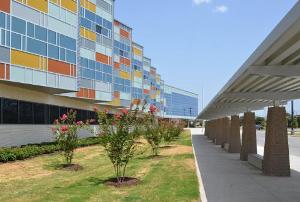Aug 27 2013
Redi-Mix, LLC, a business unit of U.S. Concrete, Inc., today announced that it delivered its sustainable, low-CO2 concrete to six Dallas Independent School District (Dallas ISD) schools, for a net savings of 108.7 million pounds of CO2 emissions.
 Exterior of Billy Earl Dade Middle School in Dallas, TX (PRNewsFoto/U.S. Concrete, Inc.)
Exterior of Billy Earl Dade Middle School in Dallas, TX (PRNewsFoto/U.S. Concrete, Inc.)
It was also announced that U.S. Concrete's Aridus® Rapid Drying Concrete was used at the Billy Earl Dade Middle School construction project to address aggressive scheduling requirements, cutting the construction schedule by 30 percent and yielding a similar reduction in construction overhead costs.
U.S. Concrete's Low CO2 Concrete Mixes Reduce Carbon Footprint for Dallas Schools
U.S. Concrete's National Research Laboratory, USC Technologies, Inc., developed a low-CO2 concrete technology and process, known as EF Technology®, to reduce carbon emissions. This process cuts the Portland cement content, a major contributor to greenhouse gas emissions, and uses cement replacement materials. These engineered mixes not only deliver carbon emissions savings, as compared to traditional concrete, but also deliver many higher-performing characteristics. Since 2009, U.S. Concrete and its operating companies have saved more than 1 million tons of CO2 from entering the atmosphere.
To address the Dallas Independent School District's sustainability goals, low-CO2 mixes were selected for six of the district's schools, and the majority of the materials were locally sourced. U.S. Concrete's local business unit, Redi-Mix, LLC, delivered these sustainable mixes to the following schools: Billy Earl Dade Middle School, Clinton P. Russell Elementary School, Ebby Halliday Elementary School, Thelma Page Richardson Elementary School, W.H. Adamson High School and Wilmer-Hutchins Elementary School.
U.S. Concrete's Aridus Rapid Drying Concrete Cuts Construction Schedule and Costs for Billy Earl Dade Middle School
The original construction schedule for the Billy Earl Dade Middle School was 14 months, risking failure to meet today's August 26, 2013, opening date. Working closely with the general contractor Satterfield & Pontikes Construction, Inc., and joint venture architects Kell Munoz and KAI Texas, the construction team selected U.S. Concrete's Aridus Rapid Drying Concrete to shorten the construction schedule. The use of Aridus Rapid Drying Concrete cut the construction schedule by 30 percent (from 14 months to 10 months) and resulted in similar reductions in construction overhead costs.
Aridus Rapid Drying Concrete was developed and patented by U.S. Concrete's National Research Laboratory, USC Technologies, Inc., to address recent changes in environmental government regulations that limit or restrict Vapor Organic Compounds (VOCs) in flooring adhesives. While these new formulations can reduce the environmental impact of new flooring installations, the new adhesives are less durable and more susceptible to moisture-related issues. As a result, contractors have been forced to combat the problems by adding sealers or lengthening the drying time of the concrete, in hopes of reducing the risk of liabilities associated with the failures of floor coverings. In addition, these remedies increase the construction time and costs associated with the projects.
Aridus Rapid Drying Concrete consumes the excess water and accelerates the drying time, eliminating extended drying times and the need for costly and time-consuming topical products such as epoxies. As a result, Aridus Rapid Drying Concrete not only prevents moisture-related flooring covering failures, but also allows contractors to reduce construction schedules and costs. This has led to architects and contractors specifying Aridus Rapid Drying Concrete for their flooring projects nationwide. To view Project Profiles, visit: https://www.us-concrete.com/
"We have seen, first-hand, projects negatively impacted by the changes in adhesives and the resulting emulsification. Aridus Rapid Drying Concrete not only prevents moisture-related floor covering failures, but it significantly reduced the construction schedule for this project," said architect Randy Barnett with KAI Texas. "Within 21 days we were able to achieve the acceptable standard of measures to start receiving the floor. This was phenomenal. It typically takes anywhere between four to six months, even as much as eight months, to get below 80 percent relative humidity inside standard concrete."